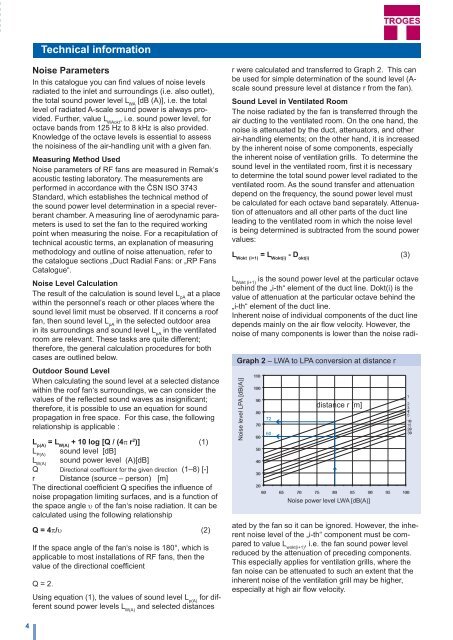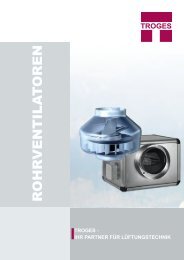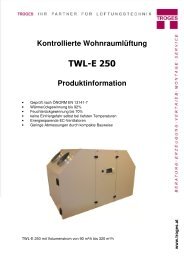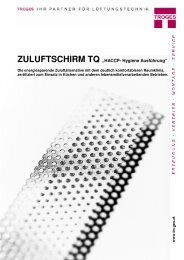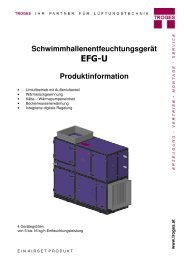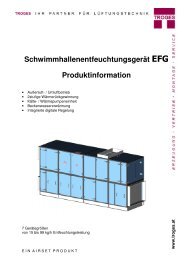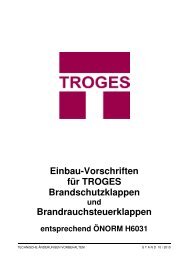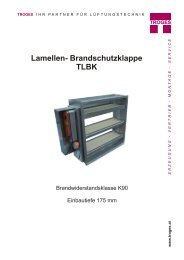Roof fans - Troges
Roof fans - Troges
Roof fans - Troges
You also want an ePaper? Increase the reach of your titles
YUMPU automatically turns print PDFs into web optimized ePapers that Google loves.
RF Fans<br />
Technical information<br />
Noise Parameters<br />
In this catalogue you can find values of noise levels<br />
radiated to the inlet and surroundings (i.e. also outlet),<br />
the total sound power level L WA<br />
[dB (A)], i.e. the total<br />
level of radiated A-scale sound power is always provided.<br />
Further, value L WAokt<br />
, i.e. sound power level, for<br />
octave bands from 125 Hz to 8 kHz is also provided.<br />
Knowledge of the octave levels is essential to assess<br />
the noisiness of the air-handling unit with a given fan.<br />
Measuring Method Used<br />
Noise parameters of RF <strong>fans</strong> are measured in Remak‘s<br />
acoustic testing laboratory. The measurements are<br />
performed in accordance with the ČSN ISO 3743<br />
Standard, which establishes the technical method of<br />
the sound power level determination in a special reverberant<br />
chamber. A measuring line of aerodynamic parameters<br />
is used to set the fan to the required working<br />
point when measuring the noise. For a recapitulation of<br />
technical acoustic terms, an explanation of measuring<br />
methodology and outline of noise attenuation, refer to<br />
the catalogue sections „Duct Radial Fans: or „RP Fans<br />
Catalogue“.<br />
Noise Level Calculation<br />
The result of the calculation is sound level L pA<br />
at a place<br />
within the personnel’s reach or other places where the<br />
sound level limit must be observed. If it concerns a roof<br />
fan, then sound level L pA<br />
in the selected outdoor area<br />
in its surroundings and sound level L pA<br />
in the ventilated<br />
room are relevant. These tasks are quite different;<br />
therefore, the general calculation procedures for both<br />
cases are outlined below.<br />
Outdoor Sound Level<br />
When calculating the sound level at a selected distance<br />
within the roof fan‘s surroundings, we can consider the<br />
values of the reflected sound waves as insignificant;<br />
therefore, it is possible to use an equation for sound<br />
propagation in free space. For this case, the following<br />
relationship is applicable :<br />
L p(A)<br />
= L W(A)<br />
+ 10 log [Q / (4π r 2 )] (1)<br />
L P(A)<br />
sound level [dB]<br />
L W(A)<br />
sound power level (A)[dB]<br />
Q Directional coefficient for the given direction (1–8) [-]<br />
r Distance (source – person) [m]<br />
The directional coefficient Q specifies the influence of<br />
noise propagation limiting surfaces, and is a function of<br />
the space angle υ of the fan‘s noise radiation. It can be<br />
calculated using the following relationship<br />
Q = 4π/υ (2)<br />
If the space angle of the fan‘s noise is 180°, which is<br />
applicable to most installations of RF <strong>fans</strong>, then the<br />
value of the directional coefficient<br />
Q = 2.<br />
Using equation (1), the values of sound level L p(A)<br />
for different<br />
sound power levels L W(A)<br />
and selected distances<br />
r were calculated and transferred to Graph 2. This can<br />
be used for simple determination of the sound level (Ascale<br />
sound pressure level at distance r from the fan).<br />
Sound Level in Ventilated Room<br />
The noise radiated by the fan is transferred through the<br />
air ducting to the ventilated room. On the one hand, the<br />
noise is attenuated by the duct, attenuators, and other<br />
air-handling elements; on the other hand, it is increased<br />
by the inherent noise of some components, especially<br />
the inherent noise of ventilation grills. To determine the<br />
sound level in the ventilated room, first it is necessary<br />
to determine the total sound power level radiated to the<br />
ventilated room. As the sound transfer and attenuation<br />
depend on the frequency, the sound power level must<br />
be calculated for each octave band separately. Attenuation<br />
of attenuators and all other parts of the duct line<br />
leading to the ventilated room in which the noise level<br />
is being determined is subtracted from the sound power<br />
values:<br />
L Wokt (i+1)<br />
= L Wokt(i)<br />
- D okt(i)<br />
(3)<br />
L Wokt (i+1)<br />
is the sound power level at the particular octave<br />
behind the „i-th“ element of the duct line. Dokt(i) is the<br />
value of attenuation at the particular octave behind the<br />
„i-th“ element of the duct line.<br />
Inherent noise of individual components of the duct line<br />
depends mainly on the air flow velocity. However, the<br />
noise of many components is lower than the noise radi-<br />
Graph 2 – LWA to LPA conversion at distance r<br />
Noise level LPA [dB(A)]<br />
distance r [m]<br />
<br />
<br />
Noise power level LWA [dB(A)]<br />
ated by the fan so it can be ignored. However, the inherent<br />
noise level of the „i-th“ component must be compared<br />
to value L wokt(i+1)<br />
, i.e. the fan sound power level<br />
reduced by the attenuation of preceding components.<br />
This especially applies for ventilation grills, where the<br />
fan noise can be attenuated to such an extent that the<br />
inherent noise of the ventilation grill may be higher,<br />
especially at high air flow velocity.<br />
<br />
4


